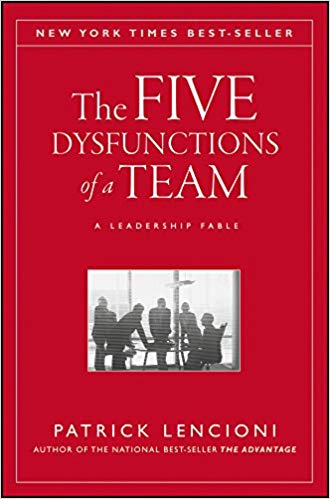

This article gives you a glimpse of what you can learn with Shortform. Shortform has the world’s best guides to 1000+ nonfiction books, plus other resources to help you accelerate your learning.
Want to learn faster and get smarter? Sign up for a free trial here .
What is the importance of team-building? How do you foster healthy communication in your company?
Behind every great company is a team running the machine. And behind every great team is a leader who understands the importance of team-building.
Let’s look at four reasons why team-building is essential for every company, whether it’s a startup or a multimillion-dollar business.
1. Team-Building Improves Communication and Relationships
One of the most crucial qualities of a well-oiled team is communication. If a leader doesn’t take the time to build a close-knit team, then the relationships will suffer. In Tribal Leadership, Dave Logan, John King, and Halee Fischer-Wright recognize that a team that acts like a cohesive tribe communicates well with one another about their work.
If you want your team to collaborate more through clear and effective communication, you need to implement team-building exercises. A group activity where everyone tells a fun fact about themselves, or expresses what their strengths and weaknesses are would be sufficient. After taking careful consideration into what your team needs, they’ll display these three markers of communication:
Marker #1: A strong and explicit commitment to shared values. A team that emphasizes the importance of team-building develops shared values—the tribe members and leaders discuss and articulate their values together. With values made explicit, the members of a tribe recognize their shared identity, and they begin to see each other as kin and allies.
According to the authors, an organization dominated by cohesive teams finds creative ways to express and embody its values. For instance, it might replace cubicles with modern co-working spaces to encourage teamwork. Or it might reimagine how meetings work, allowing anyone from anywhere in the hierarchy to contribute equally to the conversation.
Marker #2: Tribe-centered language. In a culture that focuses on team-building, the prevailing mood is one of camaraderie and authenticity, and the language reflects this. Both tribe members and leaders often praise one another, expressing how great it feels to be part of such a strong, collaborative organization. According to the authors, they use “we’re great” language.
Marker #3: Strong, networked relationships. Individuals form networked relationships—that is, they always interact with at least two other individuals. To an individual that values teamwork, the tribe comes first, so he’s always looking to build strong relationships or introduce people he thinks might work well together. Given this, multi-person networking dominates social occasions, and everyone works to strengthen and expand the tribe’s relationships.
Tribal Leadership
by Dave Logan, John King, and Halee Fischer-Wright
46 min reading time
22.3k reads
audio version available
Implementing Peer Feedback
A strong leader will pair people up to work on projects or make decisions. These pairings enhance peer relationships and make the entire team stronger. When Trillion Dollar Coach’s author Bill Campbell paired people up at companies—especially people who hadn’t worked together before—he knew he was building alliances and trust within a team.
Example: In 2008, Campbell asked Jonathan Rosenberg, senior vice-president of products, to seek out Google’s new CFO Patrick Pichette, and mentor him. This helped Pichette navigate his way around a new environment, but more importantly, it created a new pair of trusting teammates on CEO Schmidt’s team.
Because Campbell believed that peers were better at evaluating each other than managers were at evaluating their subordinates, he helped to develop a peer feedback survey at Google. The survey examined job performance, relationships with peer groups, leadership, innovation, and behavior at meetings.
These surveys build trust between team members because they feel honest enough to critique their peers, while also opening up a line of communication that allows people to help each other.
2. Individuals Become Comfortable With Conflict
Passionate, ideological conflict is necessary for teams to learn from past mistakes, take decisive action, and tap into the full team’s talent and experience, says Patrick M. Lencioni in The Five Dysfunctions of a Team. But dysfunctional teams have a fear of conflict.
Fear of conflict is a direct outgrowth of an absence of trust. Without the guardrails that trust provides, teammates will be fearful that any conflict will devolve into personal sniping and unproductive arguing—so they avoid conflict altogether. Companies that understand the importance of team-building don’t have this problem, because their conflicts are about substantive issues, not personal feelings.
Productive, ideological conflict is different from interpersonal conflict. Ideological conflict is driven by concepts, ideas, and goals. Teams avoid these discussions because they fear (often correctly) that they will get heated and become uncomfortable. But that’s ok! Passion, emotion, and even frustration are all natural and important parts of the process.
What’s not ok is when conflict is rooted in interpersonal politics. This kind of ideas-free conflict achieves nothing and only leads to bitterness and resentment that lingers after the argument is over.
In an environment absent of trust and healthy conflict, teams substitute artificial harmony for productive conflict, pretending to agree with one another to avoid the discomfort that comes with toxic conflict. Without regular, healthy conflict, hostilities and tensions simmer just beneath the surface, coming out as personal attacks, sarcastic and biting remarks, and passive-aggressive undermining.
The consequences of fear of conflict are also deeply harmful to a team. Mistakes that might have been exposed or resolved through open debate go undiscovered and unfixed, leading to wasted time and effort as the team continues pursuing the same wrongheaded course. Since these teams also shy away from discussing controversial topics, major opportunities are squandered through inaction.
How to Get Teams to Properly Handle Conflict
The general theme to fixing a fear of conflict is by encouraging teams to deal directly with sources and topics of disagreement, rather than ignoring them. Once they see that conflict can be a productive endeavor, they will get comfortable making it a more regular part of their decision-making process.
Teams that employ the following strategies can engage in constructive conflict free of personal grudges. This is why team-building is important—they learn to discuss and resolve issues as soon as they arise and focus on ideological arguments, rather than personal rivalries.
- Mining: This involves teams bringing up previous disagreements and forcing them to work through issues that they would otherwise avoid. This direct acknowledgment is key, since not talking about a conflict doesn’t resolve the underlying issue at all—it just causes it to manifest in other, more destructive forms (like personal grudges).
- Real-time permission: Here the leader coaches and encourages the conflict. When people get uncomfortable with conflict, the leader reminds the team that debate is a productive and necessary part of team-building. Since dysfunctional teams are often accustomed to team leaders suppressing debate or shielding individuals from conflict, this exercise reverses that effect and gives the team the confidence and permission structure to continue with debate.
- The leader’s role: To promote healthy and productive conflict, a leader must resist the urge to protect the team from peer criticism. Stifling a lively debate is one of the worst mistakes a leader can make. They must also model appropriate conflict behavior by never engaging in personal attacks themselves and always bringing their own sources of disagreement to light.
The Five Dysfunctions of a Team
by Patrick M. Lencioni
15 min reading time
25.8k reads
audio version available
3. Empowers Team Members to Act on Their Own
Leaders should be able to trust their teams to act quickly on their feet without assistance if need be. For teams to respond effectively in a crisis, members need to be empowered to act on their own based on their training, rather than waiting for instructions from authorities who aren’t present or who can’t formulate a response to every aspect of a complex situation.
Two examples of critical airline incidents illustrate the importance of team-building and empowerment, as read in Stanley McChrystal’s Team of Teams. The key difference between the two incidents was that in the first, crew members felt empowered to act immediately (adapt), while the second crew followed a command-and-control structure in which they waited for the captain’s orders (they failed to adapt).
US Airways 1549
The story of US Airways Flight 1549 is well-known. It was the plane that Captain Chesley Sullenberger landed safely on New York’s Hudson River in 2009 after hitting a flock of geese, which disabled the engines.
The crew had only moments to respond to the crisis, which occurred at only 2,000 feet (emergency training addresses engine failure at 20,000 feet but not below that). Every member of the crew sprang into action without being told what to do. In less than four minutes, they turned the plane around, prepared for a crash landing, and splashed down on the Hudson. Everyone on board survived as a result of the empowered teamwork—Sullenberger wouldn’t have had time to assign and supervise all the crew members and still land the plane safely.
United Flight 173
In contrast, United Flight 173, en route from New York to Portland in 1978, crashed, killing two crew members and seriously injuring 24 people.
The tragedy began when the aircraft developed a minor problem with landing gear while nearing Portland—the gear was down but the crew didn’t know it due to an indicator light not working. When they finally determined the gear was down, they weren’t sure the wheel suspension was working, in which case the wheels could collapse upon landing.
Rather than functioning as an adaptive team, the crew waited to act until they received instructions from the captain, who alone decided what steps to take. The crew then spent 70 minutes following instructions to prepare for an emergency landing—which was five minutes beyond the plane’s fuel capacity. The captain was so focused on ensuring that everyone followed their protocols for a rough landing that he didn’t check the fuel gauge. The plane lost its engines before reaching the runway, and it crashed into two empty houses and many trees.
4. Team-Building Encourages Meaningful Work
According to Nine Lies About Work by Marcus Buckingham and Ashley Goodall, organizations emphasize building a strong corporate culture with perks (like foosball tables) because they believe that it can motivate employees to work smarter and harder.
However, the authors argue that team-building is a more efficient way to encourage meaningful work because it addresses employees’ deeper needs, not just surface-level wants. More than having free lunches and other perks, employees seek to do meaningful work as part of a supportive, collaborative team—one that sees them as individuals with unique strengths, makes them feel like they’re a part of something bigger, and doesn’t treat them like just another cog in a well-oiled machine.
As a leader, you have the power to give your employees the team they’re looking for. The authors recommend focusing on the importance of team-building so they can produce high-quality work. To do this, get to know each member, ensure they understand their role, recognize their accomplishments, and foster trust within your team.
Nine Lies About Work
by Marcus Buckingham and Ashley Goodall
12 min reading time
56.7k reads
audio version available
Wrapping Up
Even if your employees work great as individuals, it’s a good idea to encourage working together to create more substantial work. If you communicate the importance of team-building to them, they’ll get on board and unlock your company’s potential.
Are there other reasons why team-building is important for businesses? Let us know in the comments below!

Want to fast-track your learning? With Shortform, you’ll gain insights you won't find anywhere else .
Here's what you’ll get when you sign up for Shortform :
- Complicated ideas explained in simple and concise ways
- Smart analysis that connects what you’re reading to other key concepts
- Writing with zero fluff because we know how important your time is











